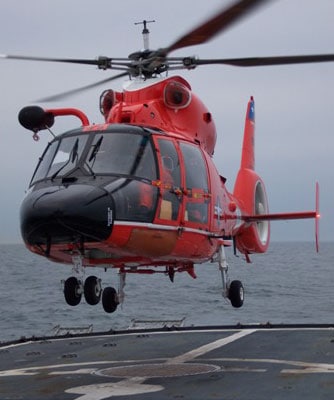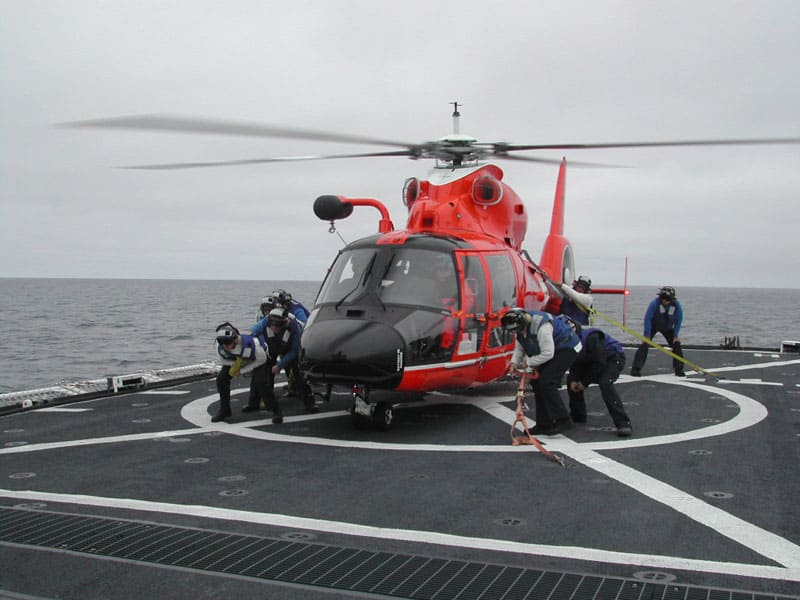
The United States Coast Guard added 96 Short Range Recovery (SRR) HH-65A helicopters to its fleet to replace the HH-52A Sikorsky Sea Guard. The twin-engine Dolphins operate up to 150 miles offshore and will fly comfortably at 120 knots for three hours. Though normally stationed ashore, the Dolphins can be carried onboard medium and high endurance Coast Guard Cutters. The cutters are capable of refueling and supporting the helicopter for the duration of a patrol. Unlike the HH-52, the HH-65A is not able to perform water landings.
The SRR is utilized for Search and Rescue, enforcement of laws and treaties, including drug interdiction, polar ice breaking, marine environmental protection including pollution control, and military readiness. Helicopters carried on Coast Guard cutters greatly enhance surveillance capabilities and mission effectiveness.
The HH-65A minimum equipment requirements exceeded anything previously packaged into one helicopter weighing in at less than 10,000 pounds. HH-65As are made of corrosion-resistant, composite-structure materials. The shrouded tail rotor is unique to the Dolphin. The HH-65A is equipped with a computerized flight management system that integrates state-of-the-art communications and navigation equipment. This system provides automatic flight control. At the pilot’s direction, the system will bring the aircraft to a stable hover 50 feet above a selected object. This is an important safety feature in darkness or inclement weather. Selected search patterns can be flown automatically, freeing the pilot and copilot to concentrate on sighting the search object.
The TALON deck landing system is utilized for the HH-65. It consists of a helicopter mounted hydraulic probe and a six-foot diameter shipboard mounted honeycombed grid. After the helicopter touches down, the probe is activated by the pilot to engage the grid. The probe contacts and locks into the grid by applying and maintaining a hold-down force. To save weight, the probe can be easily removable and can be installed when the HH-65 is deployed to a ship.
[fusion_table hide_pop_tinymce=””]
| MH-65C | Short Range Recovery (SRR) helicopter twin-engine |
| Manufacturer | Aerospatiale |
| Overall Length | 44 ft. 5 in |
| Rotor Diameter | 39 ft. 2 in |
| Overall Height | 13 ft. 5 in |
| Maximum Gross Weight | 9,480 lbs. |
| Empty Mission Weight | 6.896 lbs |
| Fuel Capacity | 291 gal / 1900 lbs |
| Powerplants | 2 x 835 hp Turbomeca Arriel 2C2-CG turboshaft- engines |
| Maximum Range | 355 nautical miles |
| Radius of Action | 177 nautical miles |
| Maximum Speed | 175 knots |
| Cruising Speed | 148 knots |
| Service Ceiling | 10.000 feet above sea level |
| Armament | 7.62 M240 B/H machine gun |
| .50 caliber shoulder precision weapon | |
| Rescue Hoist Capacity | 600 lbs |
| Number of pilots | 2 |
| Number flight crew | 1 Hoist operator 1 Rescue swimmer |
[/fusion_table]

A SRR mission analysis began in 2000. An upgraded version of the HH-65, re-designated as a Multi-Mission Cutter Helicopter (MCH), under the Integrated Deepwater Program was programmed. A Service Life Extension Program (SLEP), including airframe upgrades, landing gear upgrade, improved fenestron (tail rotor), updated avionics, increased payload, additional fuel carrying capabilities and increased cruise speed has been completed. The aircraft has been re-engined with the Turbomeca Ariel 2C2-CG giving the HH-65B greater power, better maneuverability and an increased power margin. All HH-65 helicopters were upgraded and designated MH-65C as of 2008. The MH-65Cs variant reflects the installation of armament and a significantly upgraded communications system. Helicopter Interdiction Tactical Squadron (HITRON) Jacksonville was the first operational Coast Guard unit to employ the MH-65C. It replaced the MH-68A Stingray aircraft.
The transition to the MH-65D was designed to address obsolete component issues. Two imbedded GPS/inertial navigation systems and two control display units. The upgrade began in 2011 and completed in 2015. In December 2018 a Service life extension (SLEP) and equipment upgrade began. Designated MH-65E, the SLEP replaces five major structural components within the helicopter. These changes will increase the service life of the aircraft by 10,000 flight hours. The avionics upgrades include a digital cockpit display with advanced navigational capabilities and a common Avionics architecture that is shared by the MH-60T helicopter and similar Department of Defense aircraft. upgraded digital weather and surface radar.

